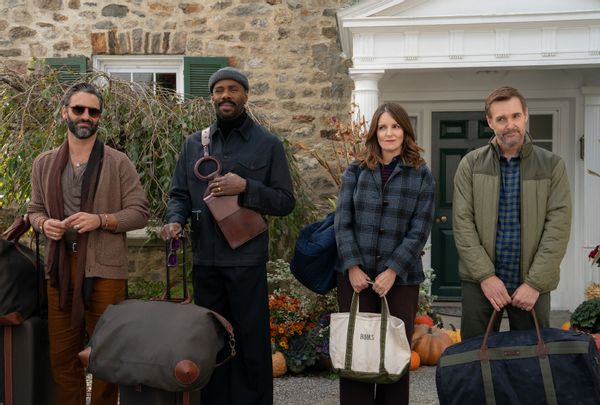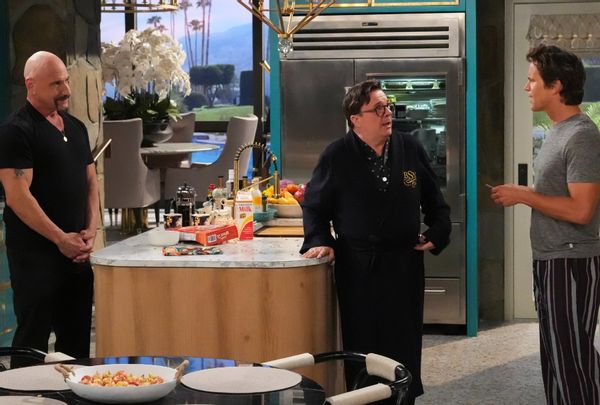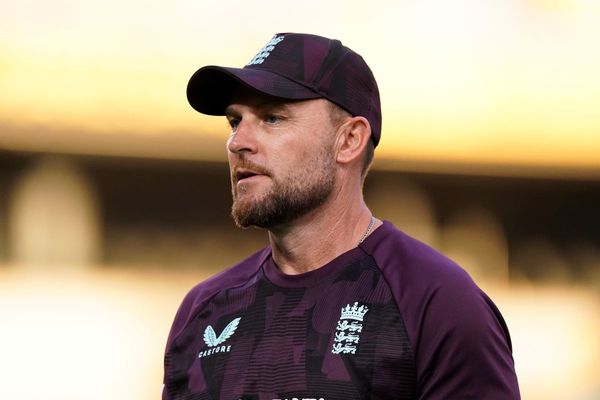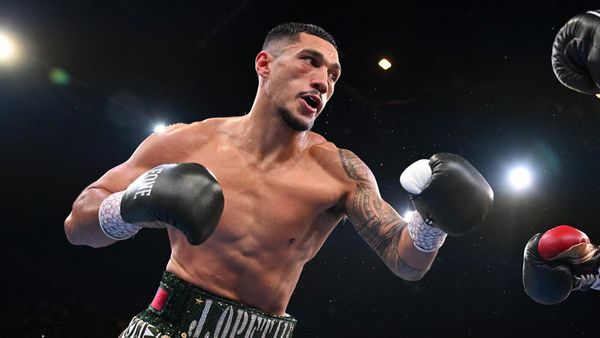
Three seasons into our collective “And Just Like That . . ." journey, let us hope, if not assume, that few of us are watching for the life hacks. The fashion is impractical, the lifestyles unsustainable, and the New York dating scene is . . . depicted realistically, from what I'm told.
For the most part, the continuing adventures of Carrie Bradshaw (Sarah Jessica Parker), Miranda Hobbes (Cynthia Nixon) and Charlotte York Goldenblatt (Kristin Davis) are fantasies. New friendships with other 50-somethings blossom effortlessly, although Season 3 winnows the lunch crew expansion pack to the recently introduced Seema Patel (Sarita Choudhury) and Charlotte’s schoolyard bud Lisa Todd Wexley (Nicole Ari Parker).
Careers, for those who still need them, are easily obtained and maintained. Ditto for real estate. There are no inappropriate fashion choices. Only in this show could a woman of a certain age stroll through a public space with a collapsed gingham cervical cap on her head and have strangers behave as if nothing is amiss.
Indeed, the only obstacles to this quintet’s sustained bliss are fear and malaise.

The only person who seems to be thriving in all life quadrants — life, love, mood and career – is Anthony Marentino, Mario Cantone’s still-putting-up-with-this gay best friend.
Ah, yes – the gay BFF, that old trope. Back in the early '00s, Anthony and Carrie’s arm candy, Stanford Blatch (the late Willie Garson), were the poster models for everything we came to despise about the stereotype. There's a searing piece on this very site titled "Why "Sex and the City" is bad for the gays" that unerringly spells out everything that's wrong with these two individually and as a couple.
The author, former Salon editor Thomas Rogers, describes them as "tragically asexual helpmates whose main role has always been to provide relationship advice to the show's straight female characters, fling b****y quips, or let their flamboyant outfits serve as a visual punch line." Anthony, he continues, "is the worst kind of shallow, fashion-grubbing gay minstrel." Rogers isn't wrong.
“And Just Like That” hasn’t entirely exorcised that image, although Anthony has been updated to add something more to the mix than the bracing splash of tartness flavoring Charlotte’s simple syrup personality. He's a little less shallow, but so is everyone else. He's also mired in a minor subplot, but at least he has six seasons of history for us to draw upon. None of the 2021 additions to the cast can say the same.
Anthony still isn't where we want him to be. But in this emotionally turbulent economy, I'd rather be in his shoes than anyone else's on this show.

The return of “And Just Like That,” the sustained popularity of “The Four Seasons” on Netflix, and the word-of-mouth celebration of Hulu’s “Mid-Century Modern” strike a chord because they brim with situational accuracy that makes the not-quite-old, queer and straight alike, feel simultaneously seen and attacked.
In “Four Seasons,” Steve Carell’s Nick decides to blow up his 25-year marriage to Anne (Kerri Kenney-Silver) while his fellow college buddies Kate (Tina Fey), Jack (Will Forte) and Danny (Colman Domingo) are visiting his country home. The cause of marital death, according to Nick, is boredom. “And Just Like That” already slogged through this withered territory via Steve and Miranda in what may be the show’s most realistic depiction of two people giving up on each other.
But the new season ventures into the relationship version of the Great Dismal Swamp as Carrie, an attractive, independently wealthy 50-something woman who’s already had hip surgery, agrees to refrain from contacting Aidan regularly or dating anyone else for five years. This is all so he can coddle his sulky, wild teenage son while expecting Carrie to limit all extracurricular cuddles to her adopted kitty, Shoe.
As the third season begins, everyone’s bedroom is some version of sexless or erotically deprived, even Seema’s, due to work-life imbalance, or the dreaded performance issues. Everyone, that is, except Anthony, who has kept his roses watered.
Anthony has a thriving bakery business staffed by well-endowed hunks in too-tight denim uniforms. His poet boyfriend Giuseppe (Sebastiano Pigazzi) is blessed with a baguette in his pants and never gives the audience a reason to question the state of their union.

Other area codes must settle for a tastefully decorated ranch far beyond New York’s city limits, like the one Nathan Lane’s Bunny Schneiderman shares with his mother in Palm Springs on “Mid-Century Modern.”
The Manhattan single lives of Miranda and Carrie, separately and together more often this season than previously, are marginally more compelling but also vanilla and, in Carrie’s case, kind of gross.
Done and dusted is Miranda’s disastrous affair with unfunny comic Che Diaz (Sara Ramirez) and her friendship with Professor Nya Wallace (Karen Pittman). That part is a shame. Nobody enjoyed Che’s company, but Nya had room for expansion. (Pittman decided against waiting for that to happen and chose her more substantive roles on “The Morning Show” and “Forever” instead.)

As for Carrie’s drama, it only takes a few seconds of watching Aidan licking his palm before tickling his tackle to make a person appreciate the classy way Big gave Carrie her freedom. Mr. Big’s exit hurt, but it did not assault our eyeballs.
Anthony and Giuseppe, in contrast, are faring just fine. We don’t see enough of them, but that much is obvious.
When Seema complains, “Why is it gay men never do for me what they say they’re going to do for me?” and Carrie echoes that frustration a few scenes later with, “Why can no gay man ever give you what you’re expecting?” we should recognize this as a kind of progress. For once, the show that normalized the idea of the homosexual man as an accessory is letting us know that its high-heeled heroines are not the suns around which all of gaydom revolves.
“Mid-Century Modern” takes that notion a step further. Women are to be cared for, but only if they’re family – and only under duress. Otherwise, they are comic relief. Lane’s Bunny is the dramatic Alpha in “Mid-Century Modern” to his closest confidantes, Arthur (Nathan Lee Graham) and Jerry (Matt Bomer), who come together after their other close friend dies.
Since Bunny has money and rooms, and Arthur and Jerry have little tying them to the places they call home, Bunny invites them to move in with him and his elderly mother, Sybil (the late Linda Lavin, in her final role).
Jerry works as a flight attendant, while Vogue recently tossed aside Arthur, its former fashion columnist. Both were once married or partnered up, but now they’re all living single and happy to partake in Bunny’s bottomless bar and wine cellar. None are concerned about meeting obligations to anybody but themselves and the people they love.
The familiar fuzziness of “And Just Like That” and “Mid-Century Modern” could have something to do with their shared creative DNA with classic sitcoms that promote the strength of platonic love as life’s true treasure and a shield against romantic disappointment.

It’s easy to match Bunny, Jerry and Arthur’s respective personalities to their retired Miami counterparts – dim, gentle Jerry is the Rose in this bunch, for instance – but that's not why the show works.
Mutchnick and Kohan define these men's lives on their own terms, much in the way they wrote Eric McCormack’s Will to take up space apart from Debra Messing’s Grace, making him a scene partner instead of a sidekick.
“Will & Grace” further subverted the gay bestie trope by assigning Will his own gay best friend, Sean Hayes’ Jack. And Jack has a wealthy straight woman pet to entertain him in Megan Mullally’s Karen Walker.
Karen’s relationship with her husband Stan is supported by booze and conspicuous consumption; he is absent to the degree that we never entirely see him onscreen.

Life post-divorce is represented in “Mid-Century Modern” by Bunny’s sister Mindy (Pamela Adlon), something of an aimless wreck who Bunny resolves to help onto her feet, which neither Jack nor Arthur appreciate. Mindy is bracingly funny but also masculine enough to intimidate Jerry, the delicate peacock in this gilded birdcage.
The merry unions in “And Just Like That” are more grounded and secure, but also dull. Not that there’s a problem with that – most stable marriages are dull, to outsiders anyway.
But who would watch a show about Charlotte and Harry, and LTW and Herbert, living and loving and occasionally hooting in support of their friend’s corny a cappella outfit? Nobody.
Mild marital dysfunction is at least relatable, if the sustained popularity of “The Four Seasons” can be counted as a sign. Where Miranda and Steve evoked a nation’s worth of wincing and self-examination, Kate and Jack resemble millions of devoted heterosexual duos who aren’t exactly the model of hot monogamy. “Complaining is their version of having sex,” as Danny puts it.
Fey, Lang Fisher, and Tracey Wigfield adapted “The Four Seasons” from Alan Alda’s 1981 film, which didn’t feature a same-sex couple. (Like "Sex and the City" edition Anthony, it was a product of its time.) But it’s also a kind of tale we’ve seen before in moody premium cable telefilms, like 2001’s “Dinner with Friends.” In that long-ago HBO drama, Greg Kinnear’s philandering husband chucks aside Toni Collette’s devoted but defeated wife. Their friends, played by Dennis Quaid and Andie MacDowell, brood about what that means for their marriage.
Nick’s decision has a similar effect, to some degree. Kate, Jack and Danny are understandably freaked out by his bomb drop, but the person who doesn’t lose his calm is Claude. When Danny and Kate fill him in on the possible emerging crisis, Claude simply blinks and shrugs. “Oh well!” he says. “I mean, people say things all the time, but who knows what they will really do?”
This is Claude’s philosophy, but it’s also the guiding principle of his and Danny’s partnership and part of what makes their extensively realized subplot the show’s best.
Claude and Danny’s breezy version of commitment isn’t presented as a trait of queer relationships so much as a quality of an understanding partnership. After all, they have their issues, too. Danny runs from his problems, including serious health scares. He'd rather fly off to Miami than get a simple heart procedure, or spend three months in Austin, Texas, where he can smoke and devour fatty foods in peace, rather than work out his communication breakdown with his husband.
Claude is smothering and compulsively sprinkles sunshine on everything, including tragedies. That works most of the time, especially in the bedroom. “You don’t know my husband. He gets happy from the outside in,” Claude says, explaining that all he needs is good food, oral sex and a long nap. “Everything is fixed. Everything’s fixed!” No, it's not.

Season 3 introduces Carrie’s prewar apartment in Gramercy Park as the elegant newcomer to the “And Just Like That” band. It includes an outdoor space that, for reasons, Carrie is obligated to replant from scratch. This is an apt metaphor for the show’s reset and the middle-age ideal: a late summer harvest that can be sweet but is prone to drought and blight nevertheless. We might plant hopes for luscious flowers and fruits, only for berries and daisies to arrive in abundance instead of melons and Casablanca lilies.
Smaller plants can be resilient, and we’re wise to appreciate them. Verdant gardens a few houses away still make us wonder what we should be doing differently.
Although the women in “And Just Like That” are a better hang than they were in past seasons, and Anthony’s character development is rising like his bread, I’d rather enjoy a TV relationship closer to what Danny and Claude in "The Four Seasons" have carved out for themselves. “Life is scary,” Claude tells Danny. “It’s also beautiful. That’s why we have each other. So we can go through it together.”
He’s talking about their marriage, apart from the rest of their friend ensemble, and as co-leading men in a romantic comedy staged entirely for and by them.
"And Just Like That..." premieres Thursday, May 29 on HBO Max. "The Four Seasons" is currently streaming on Netflix. "Mid-Century Modern" is currently streaming on Hulu.







